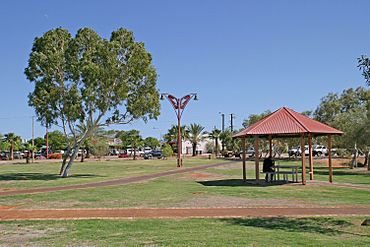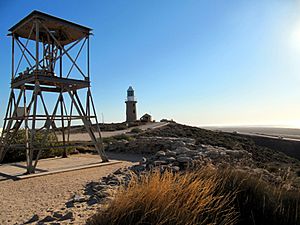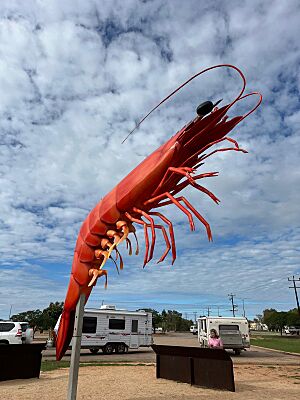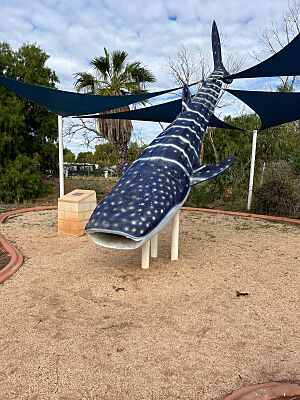Exmouth, Western Australia facts for kids
Quick facts for kids ExmouthWestern Australia |
|
|---|---|

Main park c. 2007
|
|
| Established | 1964 |
| Postcode(s) | 6707 |
| Elevation | 15 m (49 ft) |
| Area | [convert: needs a number] |
| Location | |
| LGA(s) | Shire of Exmouth |
| State electorate(s) | North West Central |
| Federal Division(s) | Durack |
Exmouth is a town located at the very tip of the North West Cape in Western Australia. It sits right on the Exmouth Gulf. This town is about 1,124 kilometers (698 miles) north of Perth, which is the capital city of Western Australia.
The town of Exmouth was started in 1967. Its main purpose was to support the nearby United States Naval Communication Station Harold E. Holt. The town gets its name from the Exmouth Gulf. Later, in the late 1970s, people from the United States Air Force also came to live here. They worked at the Learmonth Solar Observatory, a science center that Australia and the US ran together. The town is served by Learmonth Airport.
History of Exmouth
Early Explorers and World War II Base
In 1618, a ship from the Dutch East India Company called the Mauritius landed near the North West Cape. This was close to where Exmouth is today. The ship's commander, Willem Janszoon, named a river Willem's River. This river was later renamed the Ashburton River.
The area where Exmouth is now was first used as a military base during World War II. After Allied forces had to leave Java in March 1942, they needed a safe place to refuel their submarines. Submarines were the main way they could fight against the Japanese at that time. Places like Darwin, Northern Territory and Broome, Western Australia were too easy for enemy planes to attack.
So, a special base was set up near the mouth of Exmouth Gulf. It was called "Potshot". This simple base became a place for submarines to get supplies and for their crews to rest. An airfield, which is now RAAF Learmonth, was built to protect the base from air attacks. A special forces group called Z Special Unit used Potshot as a starting point for a secret mission. This mission, called Operation Jaywick, was a raid on Japanese ships in Singapore Harbour in September 1943.
Qantas Flight 72 Emergency Landing
In 2009, there was an emergency landing of Qantas Flight 72 at the nearby Learmonth Airport. This was an Airbus A330 plane. The plane's computer system got confused about how the plane was flying. It made the plane suddenly pitch down twice. This caused negative G forces, making passengers float for about 15 seconds. Luckily, no one died. However, one crew member and eleven passengers were seriously injured.
Tourism and Fun Things to Do
Exmouth's Growing Tourism
Today, Exmouth mostly relies on tourism. It's a very popular place for visitors. In 2016, about 2,486 people lived in Exmouth. But during the busy tourist season, the number of people in town can grow to 6,000!
Exmouth is famous for activities like diving and snorkeling. Some of the best places to snorkel are Turquoise Bay and Oysters Stacks.
Cape Range National Park and Solar Eclipse
The Cape Range National Park is a huge area of 506 square kilometers (195 square miles). It has many amazing gorges and is mostly located on the west coast of the Cape. The park offers many campsites along the coast. Two popular land attractions are Yardie Creek and Charles Knife Gorge.
On April 20, 2023, Exmouth was in the perfect spot to see a total solar eclipse. This was the first time a total solar eclipse was visible in Australia since 2012. More than 20,000 people came to Exmouth to watch this amazing event. The government of Western Australia spent $22 million AUD to plan and manage everything for the eclipse.
Australia's Big Things in Exmouth
Exmouth is home to two of Australia's Big Things. These are giant sculptures that are popular tourist attractions. One is The Big Whale Shark, built in 2002. The other is The Big Prawn, built in 2005. Both were created by an artist named Brian Paskins.
There's a friendly "Prawn War" between Exmouth's Big Prawn and another Big Prawn in Ballina, New South Wales. The Ballina prawn is bigger. But people in Exmouth say their prawn looks much more real!
Climate and Weather Events
Exmouth's Climate
Exmouth has a hot, dry climate, which is called a semi-arid climate. In summer, temperatures often go above 40 degrees Celsius (104 degrees Fahrenheit). However, winters are warm, with daytime temperatures around 25 degrees Celsius (77 degrees Fahrenheit).
There isn't a clear wet or dry season in Exmouth. Rain is most likely between January and July. This usually comes from monsoon showers and storms from January to April. It can also come from the edges of cold fronts in May, June, and July. Sometimes, the area is hit by tropical cyclones. The period from August to December is usually dry.
| Climate data for Learmonth Airport | |||||||||||||
|---|---|---|---|---|---|---|---|---|---|---|---|---|---|
| Month | Jan | Feb | Mar | Apr | May | Jun | Jul | Aug | Sep | Oct | Nov | Dec | Year |
| Record high °C (°F) | 48.9 (120.0) |
47.7 (117.9) |
45.5 (113.9) |
42.5 (108.5) |
37.3 (99.1) |
31.9 (89.4) |
31.7 (89.1) |
35.3 (95.5) |
41.3 (106.3) |
43.0 (109.4) |
44.2 (111.6) |
48.9 (120.0) |
48.9 (120.0) |
| Mean daily maximum °C (°F) | 37.9 (100.2) |
37.5 (99.5) |
36.5 (97.7) |
33.3 (91.9) |
28.5 (83.3) |
24.8 (76.6) |
24.3 (75.7) |
26.4 (79.5) |
29.4 (84.9) |
32.8 (91.0) |
34.6 (94.3) |
36.9 (98.4) |
31.9 (89.4) |
| Daily mean °C (°F) | 30.5 (86.9) |
30.8 (87.4) |
29.8 (85.6) |
26.9 (80.4) |
22.3 (72.1) |
19.0 (66.2) |
17.9 (64.2) |
19.3 (66.7) |
21.6 (70.9) |
24.6 (76.3) |
26.6 (79.9) |
28.9 (84.0) |
24.8 (76.6) |
| Mean daily minimum °C (°F) | 23.0 (73.4) |
24.1 (75.4) |
23.0 (73.4) |
20.4 (68.7) |
16.1 (61.0) |
13.1 (55.6) |
11.4 (52.5) |
12.1 (53.8) |
13.8 (56.8) |
16.4 (61.5) |
18.5 (65.3) |
20.9 (69.6) |
17.7 (63.9) |
| Record low °C (°F) | 16.1 (61.0) |
17.4 (63.3) |
15.0 (59.0) |
12.9 (55.2) |
7.6 (45.7) |
4.9 (40.8) |
3.5 (38.3) |
4.2 (39.6) |
5.6 (42.1) |
7.9 (46.2) |
12.0 (53.6) |
14.2 (57.6) |
3.5 (38.3) |
| Average precipitation mm (inches) | 31.0 (1.22) |
40.9 (1.61) |
40.8 (1.61) |
17.6 (0.69) |
42.2 (1.66) |
43.2 (1.70) |
22.0 (0.87) |
11.4 (0.45) |
2.1 (0.08) |
1.6 (0.06) |
1.8 (0.07) |
6.1 (0.24) |
256.7 (10.11) |
| Average precipitation days | 2.7 | 3.3 | 2.4 | 1.8 | 3.7 | 5.1 | 3.6 | 2.1 | 0.9 | 0.4 | 0.5 | 0.8 | 27.3 |
Major Weather Events in Exmouth
On March 22, 1999, a very strong storm called Tropical Cyclone Vance hit near Exmouth. It was a Category 5 cyclone, which is the strongest kind. The winds reached 267 kilometers per hour (166 miles per hour) at Learmonth, which is 35 kilometers (22 miles) south of Exmouth. This was the strongest wind gust ever recorded on the Australian mainland! Cyclone Vance caused a lot of flooding and damage to buildings. But luckily, no one was hurt.
In April 2014, Exmouth was hit by a huge flash flood. This flood almost destroyed the caravan park and badly damaged much of the town's buildings and roads. This was a big setback for tourism in the area.
See also
 In Spanish: Exmouth (Australia) para niños
In Spanish: Exmouth (Australia) para niños




